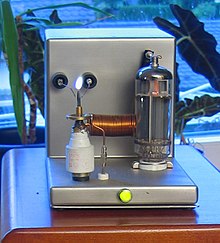Plasma tweeter
A plasma speaker is a tweeter speakers without membrane . The oscillation is generated by a plasma flame .
Although it is often called the Tesla tweeter , the plasma tweeter was neither invented nor built by Nikola Tesla . He just often uses components invented or coined by Tesla, such as the resonance coil . This is a Tesla coil .
Working principle
Plasma tweeter
In the case of ion speakers or plasma tweeters, the physical properties of the air are used to expand when heated. A high-voltage amplifier is used to generate a luminous air plasma between a brass anode and a brass cathode in a glass tube , the volume of which changes with the amplitude and frequency of the music.
Ion tweeter
Ion tweeters are also built that work with high frequency, the discharge is emitted directly into the ambient air by a tungsten tip. The ion tweeter in itself is theoretically very close to the ideal high-frequency transducer, as its membrane (air) works virtually mass-free and no partial vibrations (bending) that lead to the tonal discoloration of normal membrane materials can occur. The tweeter is designed either as an omnidirectional radiator (Magnat, developed by the physicist Siegfried Klein) or with a horn attachment for higher sound pressure .
An ion tweeter works by amplitude modulating a high frequency oscillator . This is also done to "embed" a sound signal in the transmission frequency of a radio station. However, the high frequency that would be radiated via an antenna in a radio transmitter is passed into the resonance coil in a plasma tweeter. The voltage is stepped up to 10–20 kV by the resonance coil, the voltage bulge is at the end of the coil. An electrode is connected there. The high voltage on this electrode ionizes the air so that a plasma flame becomes visible ( corona discharge ).
The flame size follows the amplitude modulation and thus the energy input in a thermodynamic cycle . By changing the volume of the flame, the surrounding air is accelerated and sound is emitted. The adaptation of the oscillating flame to the radiation resistance of the surrounding air is optimal, so that a broad, phase-linear frequency response is achieved.
A similar principle is also used with modulated Tesla transformers . They can also be used to generate a sound.
Practical features
The frequency response can be measured from 2500 Hz to over 100 kHz (the usual measurement microphones do not go any further; estimates go up to 800 kHz). The auditory perception but the people already ends at 20 kHz. The phase-locked reproduction of the working principle offers no advantages for human hearing. It has to be abandoned anyway by a necessary crossover and the spatially separated installation of the sound generator for the mid and high range ( group delay ).
In addition, sound generation faces similar problems that apply to more conventional loudspeakers. Even when the mechanical work is diverted from the thermal energy of the gas, signal distortions arise due to the non-linear characteristic. The thermal energy introduced is diverted through thermal radiation and a continuous exchange of the working gas. Both processes can only be carried out in a controlled manner with greater effort.
The maximum available sound energy is proportional to the surface of the flame and therefore remains very limited. For example, around 85 to 95 dB are specified as the maximum level at a distance of one meter. Modern dome tweeters, on the other hand, briefly reach 105 dB to 115 dB maximum sound pressure with negligible distortion. Horn systems are regularly operated at 125 dB continuous sound pressure.
For a practical system, the flame size must be kept constant even over long operating times (years). Because it can necessarily be changed by the signal, further distortion occurs through intermodulation .
The all-round radiation can impair the seamless combination with midrange and woofer. The omnipolar version differs in this respect from the variant bundled by a horn , which in turn takes on its disadvantages.
Another problem with this sound conversion method is that the strong ionizing field generates larger amounts of nitrogen oxides which, when interacting with the oxygen in the air, form ozone . By using catalysts in modern constructions, the odor nuisance that is evident in older systems can now be almost completely avoided. Damage to health - especially during prolonged operation - cannot be ruled out.
The high frequency required for ionization must remain well and safely shielded for the duration of the operation in order to avoid interference with radio traffic.
literature
- Nikola Tesla: My works. 6 vols. Michaels-Verlag ISBN 3-89539-247-2
- Thomas Görne: Sound engineering. 1st edition, Carl Hanser Verlag, Leipzig 2006, ISBN 3-446-40198-9
- Wolfgang-Josef Tenbusch: Basics of the loudspeakers. 1st edition, Michael E. Brieden Verlag, Oberhausen 1989, ISBN 3-980-1851-0-9
Web links
Individual evidence
- ↑ "Ulrich Haumann Plasma Speaker Homepage". Retrieved May 27, 2018 .
